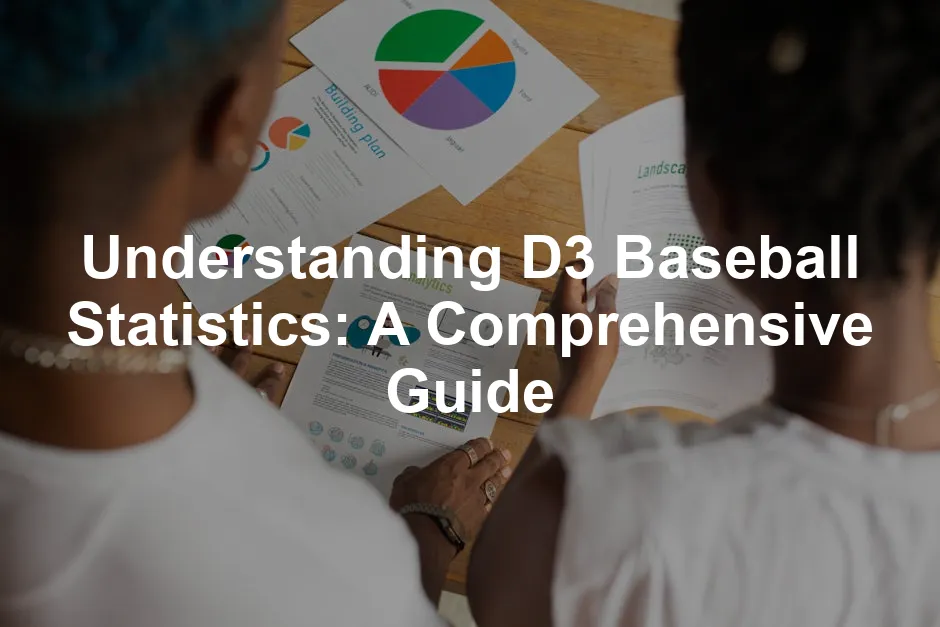Introduction
Welcome to the world of NCAA Division III (D3) baseball! This level of college baseball is where student-athletes put their skills to the test, all while juggling academics and life. D3 baseball is unique because it emphasizes the balance between sports and education, allowing players to enjoy the game without the pressure of athletic scholarships.
Statistics play a crucial role in baseball, helping evaluate both players and teams. Just like detectives, coaches and fans analyze numbers to uncover performance trends and potential. College baseball statistics are particularly important. They help coaches recruit talent, assess player development, and strategize for success.
In this guide, we will cover the ins and outs of D3 baseball statistics. We’ll explore individual and team statistics, discuss their significance, and provide tips on how to access and interpret them. By the end, you’ll be equipped to appreciate the intricacies of D3 baseball statistics. So, grab your favorite snack, and let’s get into the numbers!

Understanding D3 Baseball Statistics
What is D3 Baseball?
NCAA Division III baseball is one of the three divisions of college baseball in the United States. It consists of over 350 schools competing for regional and national titles. D3 baseball fosters a competitive atmosphere while encouraging athletes to prioritize their education.
The structure of D3 baseball includes various conferences, such as the New England Small College Athletic Conference (NESCAC) and the Midwest Conference. Each conference has its own set of teams, each bringing unique strengths and styles of play. With over 40 conferences, there’s plenty of action to follow!
Importance of Statistics in Baseball
Statistics are the lifeblood of baseball. They provide a window into player performance, helping coaches and scouts identify potential stars. At the collegiate level, statistics help assess how well players adapt to the rigors of higher competition.
The evolution of baseball statistics has been astonishing. From traditional metrics like batting average to advanced analytics such as on-base plus slugging (OPS), the game has embraced data-driven decision-making. This growing emphasis on analytics means players and teams must continuously refine their skills and strategies.
In D3 baseball, statistics also help teams evaluate their strengths and weaknesses. By analyzing data, coaches can tailor practices to address specific areas of improvement. Statistics not only inform decisions but also create a deeper connection between players and the game.

So, whether you’re a player, coach, or fan, understanding D3 baseball statistics will enhance your appreciation of the sport. Get ready to become a stats-savvy baseball aficionado!
Individual Statistics in D3 Baseball
Key Individual Statistics
Baseball is a game of numbers, and D3 baseball is no exception. Let’s break down some key individual statistics:
Batting Average (BA)
BA measures a player’s hitting success. It’s calculated by dividing the number of hits by at-bats. A higher BA indicates better performance at the plate. For instance, a player with a .300 BA has three hits for every ten at-bats. It’s the gold standard for hitters.
On Base Percentage (OBP)
OBP takes it a step further. It reflects how often a player reaches base. This statistic includes hits, walks, and hit-by-pitches, divided by plate appearances. A high OBP shows a player’s ability to get on base and contribute to scoring runs.
Slugging Percentage (SLG)
SLG measures a player’s power-hitting ability. It’s calculated by total bases divided by at-bats. A player with a high SLG hits more extra-base hits, like doubles, triples, and home runs. This stat is crucial for understanding a player’s contribution beyond just getting on base.
Earned Run Average (ERA)
For pitchers, ERA is king. It tells us how many earned runs a pitcher allows per nine innings. A lower ERA is better, indicating that the pitcher is effective in preventing runs. It’s calculated by multiplying the number of earned runs allowed by nine and dividing by innings pitched.
WHIP (Walks and Hits per Inning Pitched)
WHIP evaluates a pitcher’s effectiveness by combining walks and hits allowed. It’s calculated by adding walks and hits, then dividing by innings pitched. A lower WHIP means a pitcher keeps runners off base, showcasing control and dominance.
Strikeouts and Strikeout-to-Walk Ratio
Strikeouts show a pitcher’s ability to retire batters without allowing them to put the ball in play. The strikeout-to-walk ratio (K/BB) compares the number of strikeouts to walks issued. A higher ratio indicates a pitcher’s dominance and control over hitters.

These statistics are more than just numbers. They provide insights into a player’s strengths and weaknesses, guiding coaches and scouts in their evaluations.
And speaking of insights, have you ever thought about tracking your own baseball stats? With a Baseball Statistics Notepad, you can jot down all those important numbers, trends, and notes during games. It’s like being your own personal statistician!
Notable Individual Statistics Examples
Now, let’s look at some standout performers in D3 baseball this season based on recent statistics.
Batting Average Leaders
1. Mason Cox, Martin Luther: .469
2. Nick Marshall, Greensboro: .468
3. Jacob Charon, Lawrence: .468
4. Tommy Kreider, SUNY New Paltz: .466
5. Chris Knowles, Gustavus Adolphus: .456
These players demonstrate outstanding hitting skills. Their high batting averages reflect their ability to consistently get hits, making them critical assets to their teams.
ERA Leaders
1. Jackson Teer, Trinity (TX): 1.05
2. Sayers Collins, East Tex. Baptist: 1.23
3. Jack Haveson, Montclair St.: 1.24
4. Ryan LaPierre, Westfield St.: 1.63
5. Dylan Weber, Chris. Newport: 1.66
These pitchers have excelled in preventing runs, showcasing their dominance on the mound. Their low ERAs indicate not just skill, but also the ability to perform under pressure.
In summary, individual statistics in D3 baseball are vital for understanding player performance. They help coaches strategize and fans appreciate the game even more. So, keep an eye on these stats to see who shines on the field!

Accessing D3 Baseball Statistics
Where to Find D3 Baseball Statistics
D3 baseball statistics are like treasure maps for fans, coaches, and players. They help you track performance and evaluate talent. But where do you dig up these golden nuggets of information? Here are the best sources:
1. NCAA Official Website: This is the go-to place for official stats. The NCAA website provides comprehensive data on all divisions, including D3 baseball. Simply navigate to the stats section, and you’ll find various statistical categories.
2. D3baseball.com: This site specializes in everything D3 baseball. From player and team stats to rankings and articles, it’s a one-stop shop. The user-friendly interface makes it easy to find exactly what you’re looking for.
3. Team Websites and Conference Pages: Each D3 team has its own website, where you can find stats, game summaries, and player profiles. Additionally, conference pages often feature aggregated statistics for all teams within that conference. This is a great way to compare performances across teams.
To get the most out of these resources, familiarize yourself with the navigation. Look for sections labeled “Statistics” or “Records.” Many sites allow you to filter by season, category, or player, so you can find the specific information you need quickly.

Interpreting D3 Baseball Statistics
Now that you’ve found the statistics, it’s time to interpret them. Here are some tips to help make sense of the numbers:
1. Context Matters: Statistics are powerful, but they tell only part of the story. Consider the situation when stats were recorded. For example, a player’s performance in a high-stakes game may be more telling than their overall season average.
2. Look for Trends: Analyze how a player’s stats change over the season. Are they improving? Are there patterns that indicate specific strengths or weaknesses? Consistency is key!
3. Combine Qualitative Analysis: Statistics alone can be misleading. Pair numeric data with qualitative assessments. Watching games, noting player decisions, and observing teamwork can provide a fuller picture of performance.
4. Watch for Limitations: Statistics have their limits. A lower batting average doesn’t always mean a player is underperforming. Factors like the strength of the opposing pitcher or field conditions can influence results.
By blending statistical analysis with qualitative observations, you can gain a deeper understanding of player and team dynamics. Statistics are a tool, but they work best when combined with context and insight.

The Future of D3 Baseball Statistics
Trends in Baseball Analytics
Baseball analytics are evolving faster than a pitcher can throw a fastball. In recent years, a trend has emerged, shaking the very foundation of how we evaluate performance. Advanced metrics are now essential tools for coaches and scouts alike. For Division III (D3) baseball, this means a greater emphasis on data-driven decisions. Gone are the days of solely relying on traditional stats like batting average and earned run average.
Now, we’re looking at metrics like on-base plus slugging (OPS) and Wins Above Replacement (WAR). These advanced statistics provide a more comprehensive view of player contributions. Coaches are leveraging technology to track everything from swing mechanics to pitch rotation. Wearable devices and video analysis software are becoming commonplace in practice sessions. It’s like having a personal baseball coach in your pocket!
Moreover, teams are starting to utilize data visualization tools. These make it easier to interpret complex statistics. Coaches can adjust strategies based on real-time feedback. This trend isn’t just for professional leagues anymore; D3 programs are adapting quickly to stay competitive. They recognize that understanding the nuances of analytics can set their teams apart.

The Role of Data in Player Development
Data’s role in player development is nothing short of transformative. For D3 programs, statistics are the compass guiding recruitment efforts. Coaches analyze performance data to identify talent that fits their program’s needs. It’s a strategic approach to building a championship-caliber team.
Recruitment is becoming increasingly data-centric. Coaches now sift through mountains of statistics to find players who excel in specific areas. This not only streamlines the recruitment process but also ensures that they are bringing in players who can contribute right away.
As for player development, the future looks bright. With advancements in data analytics, coaches can pinpoint a player’s strengths and weaknesses with precision. This allows for personalized training regimens. Players can fine-tune their skills based on detailed feedback. Imagine a pitcher being told that their release point is off by just a few degrees. With that information, they can make immediate adjustments.
Looking ahead, we can expect even greater integration of data into D3 baseball. More colleges will likely adopt innovative technologies. This includes machine learning algorithms that predict player performance and injury risks. As a result, we’ll see more athletes reaching their peak potential, all thanks to the power of statistics.

In conclusion, the future of D3 baseball statistics is not just about numbers; it’s a blend of technology and strategy. The integration of advanced metrics is reshaping how we understand the game. For players, coaches, and fans, embracing this data-driven approach opens doors to deeper insights and a more engaging experience.
Conclusion
Understanding D3 baseball statistics is crucial for anyone involved in the sport. Statistics provide insight into player performance and team dynamics. They inform decisions made by coaches and shape the strategies employed during games. As we’ve explored, individual statistics like batting average, earned run average, and advanced analytics play a vital role in evaluating talent.
For players, grasping these metrics can enhance their performance. They can identify areas for improvement and set personal goals. Coaches, on the other hand, can utilize these statistics to scout and develop players effectively. Fans, too, benefit from understanding the numbers. A good grasp of statistics allows them to appreciate the game on a deeper level, fostering a stronger connection to their teams.
In a world where data is king, the importance of statistics in D3 baseball cannot be overstated. As the game continues to evolve, so will the role of analytics. Whether you’re a player aiming for success, a coach strategizing for victory, or a fan looking to understand the game better, statistics are a powerful tool. So, dive into the numbers and embrace the future of D3 baseball!

FAQs
What is the most important statistic in D3 baseball?
In D3 baseball, which statistic reigns supreme? Well, that depends on who you ask! Players, coaches, and fans often have different views on what matters most. For hitters, batting average (BA) is a fan favorite. It shows how often a player gets a hit. A solid BA can make a player a team hero. But don’t forget about on-base percentage (OBP). This sneaky statistic shows how often a player reaches base overall, including walks and hit-by-pitches. It’s great for understanding a player’s overall contribution to scoring runs. For pitchers, earned run average (ERA) is the gold standard. It reveals how many earned runs a pitcher allows per nine innings. A low ERA indicates a pitcher is like a brick wall, hard to score against. Ultimately, the most important statistic varies based on context. Are we talking about clutch situations, overall performance, or player development? Each stat shines in its own way, so it’s best to consider them all!
How can statistics help in recruiting for D3 baseball?
Statistics are like a coach’s secret weapon when recruiting. Coaches pour over numbers to find talent. They analyze player stats to identify potential recruits who fit their team’s needs. For instance, a pitcher with a low ERA and high strikeout rate is likely to catch a coach’s eye. But it’s not just about the numbers. Coaches consider a player’s performance in high-pressure situations. A player who excels in clutch moments might be more valuable than a player with average stats. Additionally, statistics help coaches communicate their vision to recruits. When discussing a player’s fit within a program, numbers provide concrete evidence. Coaches can point to specific stats that align with their team’s philosophy, making recruitment a more persuasive effort.
Where can I find historical D3 baseball statistics?
Finding historical D3 baseball statistics is easier than finding a needle in a haystack! Several resources are available for digging up past performance data. 1. NCAA Official Website: This is the granddaddy of all stat sources. The NCAA site hosts archives that span many years. You can explore individual and team stats from previous seasons. 2. D3baseball.com: This site specializes in D3 baseball and offers a treasure trove of historical data. You can find archived stats, player rankings, and team records. 3. Team Websites: Most D3 teams maintain a history of their statistics on their official sites. You can often find a dedicated section for records and past performances, making it a great resource for research. 4. Baseball Reference: This comprehensive site includes a wealth of baseball statistics, including D3 levels. It’s a reliable place to find historical data. Navigating these resources will lead you to a treasure trove of statistics that can help you understand the history of D3 baseball.
What should I consider when interpreting a player’s statistics?
Interpreting player statistics can feel like piecing together a puzzle. It’s essential to consider various factors before jumping to conclusions. Here are some key considerations: 1. Context: The situation matters. A player’s performance in a clutch game may reveal more than their overall stats. High-stakes moments can showcase a player’s true abilities. 2. Competition Level: Not all stats are created equal. A player’s performance against weaker opponents may not be as telling as their performance against tougher competition. 3. Situational Statistics: Look for situational stats, like a player’s performance with runners in scoring position. This can provide insight into their ability to deliver when it counts. 4. Injury History: A player’s past injuries can impact performance. Comparing stats from healthy seasons to those from injury-plagued years can provide clarity. By considering these factors, you can paint a more accurate picture of a player’s capabilities. Statistics are just one part of the story; context adds depth to the narrative.
Are there any comprehensive databases for D3 baseball statistics?
Absolutely! If you’re on the hunt for comprehensive D3 baseball statistics, several databases will make your life easier. Here are a few to check out: 1. NCAA Official Stats: The NCAA’s official site provides a thorough database of statistics for all divisions, including D3. You can find everything from team rankings to individual player stats. 2. D3baseball.com: This site is a beloved hub for D3 baseball fans. It offers extensive statistics, player profiles, and historical data. You can easily navigate through various categories to find what you need. 3. Baseball Reference: While primarily focused on Major League Baseball, Baseball Reference also includes college stats. You can find D3-level statistics alongside other divisions. 4. Sports Reference: This is another excellent resource for comprehensive baseball data. It includes statistics for various levels of play, including D3. These databases provide a wealth of information at your fingertips. Whether you’re a coach, player, or fan, accessing these resources will enhance your understanding of D3 baseball statistics.
Please let us know what you think about our content by leaving a comment down below!
Thank you for reading till here 🙂
For a comprehensive overview of LSU baseball statistics, check out this detailed guide.
And for those game days when you need to keep track of score, consider getting an Outdoor Baseball Scoreboard. It’s perfect for keeping everyone updated on the action without the confusion!
Also, if you’re looking to enhance your game strategy, a Baseball Coaching Clipboard is a must-have! It allows you to keep your notes organized and strategize like a pro.
All images from Pexels




